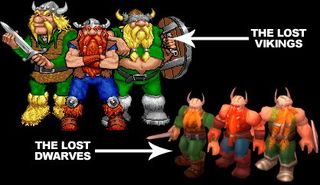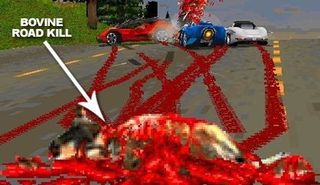101 game facts that will rock your world
Facts that mock you with their triviality
61. The Atari Jaguar proudly boasted that it was the first 64-bit console, but in reality it was two 32-bit chips stuck together - so not truly 64-bit. Those liars.
62. It's only humanly possible to press a button on a controller 16 times per second. This record was set by Toshuyuki Takahashi, a Japanese gamer.

63. A game called Malice starring singer Gwen Stefani as the titular lead character was supposed to be a big-budget system-seller for Xbox. After years of delays it was finally released at a budget price on the console, and on PS2. Gwen Stefani's recorded dialogue was never used, nor was the planned 'No Doubt' soundtrack.
64. There's a full book you can read in Deus Ex. It's called The Man Who Was Thursday by G.K. Chesterton and shares some plot similarities with the game. The chapters were spread throughout the game in datacubes.
65. If you cheated while playing the Sega 32x version of Doom, after the game ends you're taken to a fake DOS prompt. You can't quit out of it, and the only way to escape the screen is to reset the console. If you didn't cheat, you get an extra cutscene.
66. In the French localisation of Final Fantasy IX, Zidane was renamed Djidane because of the similarity to the country's most famous footballer, Zinedine Zidane.
67. Satoshi Tajiri, the creator of Pokemon, got the idea for the worldwide Game Boy phenomenon after collecting caterpillars as a child and watching them change into butterflies.

68. The voice of Shodan, the insane AI in the System Shock series, was performed by the wife of the audio director at Looking Glass. Cheaper than an actor, eh?
69. Duke Nukem 3D was one of the first games to employ a real-time audio effect to its sounds. If you went underwater, a calculated reverb was applied to sounds being played to make gunfire sound muffled and gurgly.
70. In the underground facility in Resident Evil 2 there's a locked room containing a dead Nemesis. Resident Evil 2 takes place after 3, which suggests Umbrella released more than one into Raccoon City.
71. In World Of Warcraft there's a dungeon called Uldaman where you can find and recruit three 'lost dwarves', who look very similar to characters from The Lost Vikings on SNES.

72. The first Fable was originally going to have a multiplayer mode. Four players (one hero and three sidekicks) would be able to work together to complete unique quests. This feature was cancelled in March 2004 due to time constraints.
73. Super Mario World for the SNES took 29,000 hours to program. Luckily, it went on to sell 17 million copies and was the best-selling game of its generation.
74. In the loading screen for the original Ridge Racer on PSone you could play a Galaxians-style minigame. If you destroyed all the enemies you'd unlock 8 additional vehicles.
75. Sonic The Hedgehog 2 was one of the first ever games to have a simultaneous, worldwide release date. This was known amongst gamers as 'Sonic2sday', as it appeared in shops on a Tuesday. November 24, 1992 to be exact.
76. Ico was originally meant to be released for the PlayStation, but the development was halted and then continued for the PlayStation 2. In the early version, Yorda had horns on her head, not Ico. You can find early concept footage of this on YouTube.
77. The first Broken Sword game's theme tune was composed by Barrington Pheloung, also known for writing the theme to grannies' favourite Inspector Morse.
78. Fans of Master System classic Alex Kidd In Miracle World will remember the former Sega mascot munching a hamburger at the end of each level. Originally, this was a Japanese rice ball, or onigari. It was changed because rice balls aren't as recognisable outside of Japan.
79. Violent, pedestrian-squishing racer Carmageddon was only allowed to be released in the UK with zombies instead of people roaming the streets. In the Indian version, the cows were removed, and it was banned altogether in Germany.

80. The music for the first Jak & Daxter game was composed by Mark Mothersbaugh, a member of cult '80s band Devo, and composer of all of director Wes Anderson's films including The Royal Tenenbaums and The Life Aquatic.
Sign up to the GamesRadar+ Newsletter
Weekly digests, tales from the communities you love, and more
Most Popular


